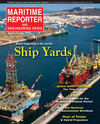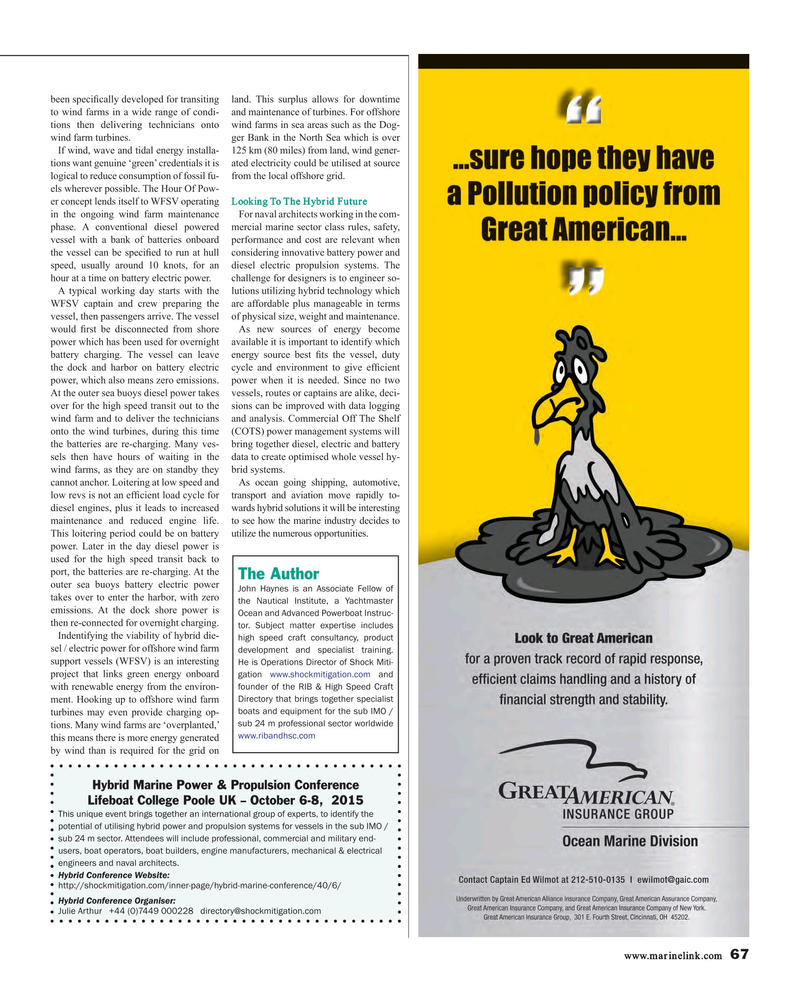
Page 67: of Maritime Reporter Magazine (August 2015)
Shipyard Edition
Read this page in Pdf, Flash or Html5 edition of August 2015 Maritime Reporter Magazine
been speci? cally developed for transiting land. This surplus allows for downtime to wind farms in a wide range of condi- and maintenance of turbines. For offshore tions then delivering technicians onto wind farms in sea areas such as the Dog- wind farm turbines. ger Bank in the North Sea which is over
If wind, wave and tidal energy installa- 125 km (80 miles) from land, wind gener- tions want genuine ‘green’ credentials it is ated electricity could be utilised at source logical to reduce consumption of fossil fu- from the local offshore grid.
els wherever possible. The Hour Of Pow- er concept lends itself to WFSV operating Looking To The Hybrid Future in the ongoing wind farm maintenance For naval architects working in the com- phase. A conventional diesel powered mercial marine sector class rules, safety, vessel with a bank of batteries onboard performance and cost are relevant when the vessel can be speci? ed to run at hull considering innovative battery power and speed, usually around 10 knots, for an diesel electric propulsion systems. The hour at a time on battery electric power. challenge for designers is to engineer so-
A typical working day starts with the lutions utilizing hybrid technology which
WFSV captain and crew preparing the are affordable plus manageable in terms vessel, then passengers arrive. The vessel of physical size, weight and maintenance.
would ? rst be disconnected from shore As new sources of energy become power which has been used for overnight available it is important to identify which battery charging. The vessel can leave energy source best ? ts the vessel, duty the dock and harbor on battery electric cycle and environment to give ef? cient power, which also means zero emissions. power when it is needed. Since no two
At the outer sea buoys diesel power takes vessels, routes or captains are alike, deci- over for the high speed transit out to the sions can be improved with data logging wind farm and to deliver the technicians and analysis. Commercial Off The Shelf onto the wind turbines, during this time (COTS) power management systems will the batteries are re-charging. Many ves- bring together diesel, electric and battery sels then have hours of waiting in the data to create optimised whole vessel hy- wind farms, as they are on standby they brid systems.
cannot anchor. Loitering at low speed and As ocean going shipping, automotive, low revs is not an ef? cient load cycle for transport and aviation move rapidly to- diesel engines, plus it leads to increased wards hybrid solutions it will be interesting maintenance and reduced engine life. to see how the marine industry decides to
This loitering period could be on battery utilize the numerous opportunities.
power. Later in the day diesel power is used for the high speed transit back to port, the batteries are re-charging. At the
The Author outer sea buoys battery electric power
John Haynes is an Associate Fellow of takes over to enter the harbor, with zero the Nautical Institute, a Yachtmaster emissions. At the dock shore power is
Ocean and Advanced Powerboat Instruc- then re-connected for overnight charging.
tor. Subject matter expertise includes
Indentifying the viability of hybrid die- high speed craft consultancy, product sel / electric power for offshore wind farm development and specialist training. support vessels (WFSV) is an interesting
He is Operations Director of Shock Miti- project that links green energy onboard gation www.shockmitigation.com and founder of the RIB & High Speed Craft with renewable energy from the environ-
Directory that brings together specialist ment. Hooking up to offshore wind farm boats and equipment for the sub IMO / turbines may even provide charging op- sub 24 m professional sector worldwide tions. Many wind farms are ‘overplanted,’ www.ribandhsc.com this means there is more energy generated by wind than is required for the grid on
Hybrid Marine Power & Propulsion Conference
Lifeboat College Poole UK – October 6-8, 2015
This unique event brings together an international group of experts, to identify the potential of utilising hybrid power and propulsion systems for vessels in the sub IMO / sub 24 m sector. Attendees will include professional, commercial and military end- users, boat operators, boat builders, engine manufacturers, mechanical & electrical engineers and naval architects.
Hybrid Conference Website: http://shockmitigation.com/inner-page/hybrid-marine-conference/40/6/
Hybrid Conference Organiser:
Julie Arthur +44 (0)7449 000228 [email protected] www.marinelink.com 67
MR #8 (66-73).indd 67 MR #8 (66-73).indd 67 8/4/2015 10:04:44 AM8/4/2015 10:04:44 AM

 66
66

 68
68
